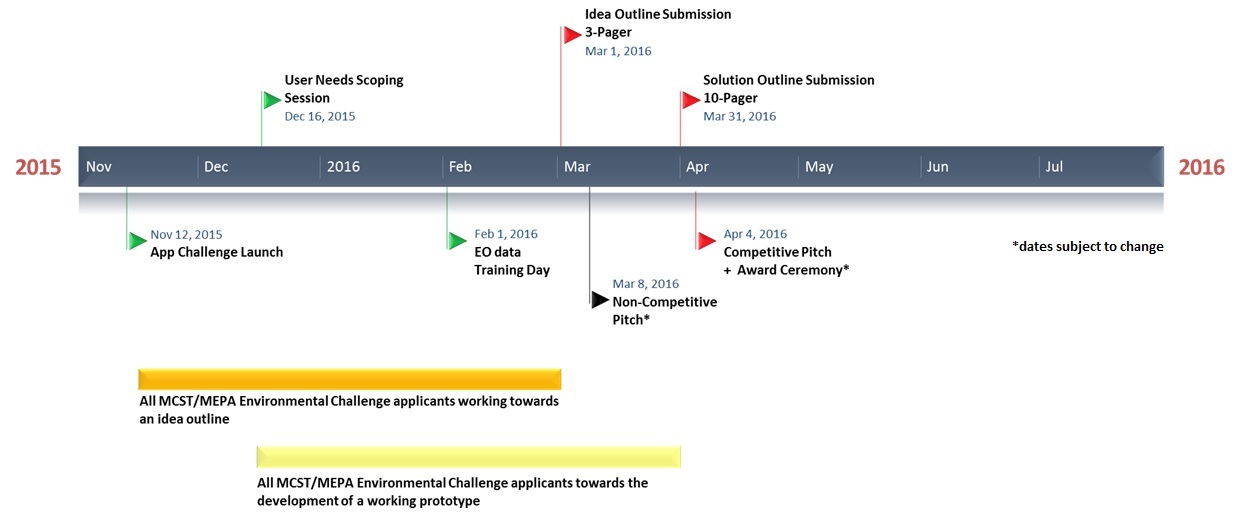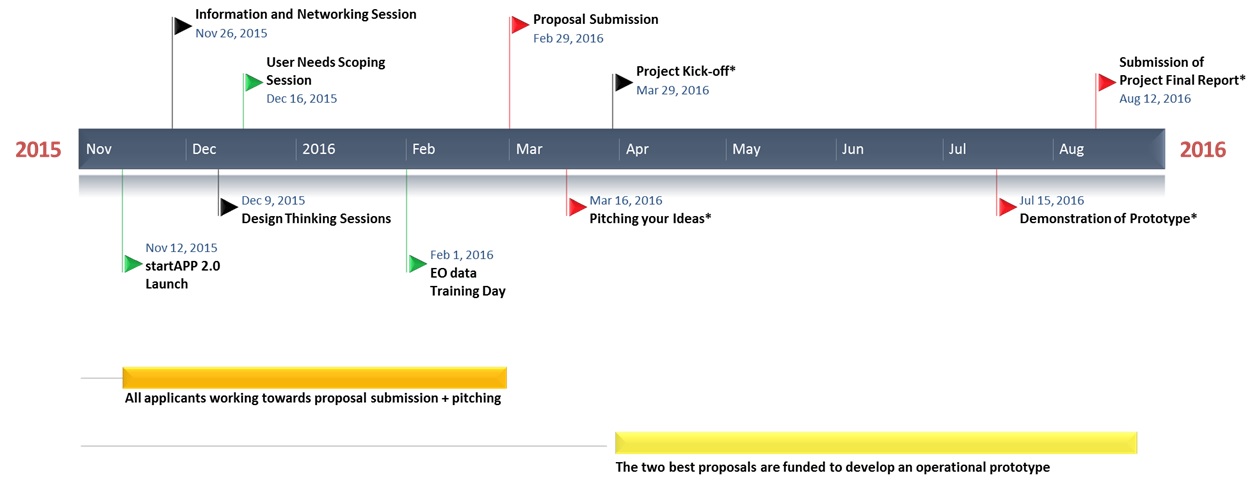The user needs scoping session
will take place on Wednesday 16th December, 10am-12pm
Takeoff, Dar Ġuzeppi Zahra Bldg, University of Malta
All applicants are invited.
See full schedule below.
The Environment and the StartAPP 2.0 challenges have different timelines, but activities in GREEN in the diagrams below are common.
Environment Challenge timeline & deliverables
Activities flagged in green are common to both challenges. Deliverables deadlines are marked in red.

Data experts will be available for questions and support throughout this period.
Idea Outline on 1 March 2016
Following the needs scoping exercise and training session, applicants are to submit a three-page Idea Outline, outlining the concept behind the application to be developed. The report, which will not be graded, should clearly outline:
- the user need addressed
- the proposed solution
- the datasets to be used in developing it.
Non-competitive pitch on 8 March 2016
The Idea Outline be followed by a non-competitive pitch during which the applicant pitches the ideas behind the app. This first pitch is not graded as it is meant to help the applicant to confirm his proposals are on the right track and adjust course if necessary.
Solution Outline on 31 March 2016
The purpose of the Solution Outline is to elaborate on the initial idea. The report should delve into the details on how the suggested solution addresses the user problem creatively, more efficiently than before, and on potential and expected impact(s) on MEPA and any other stakeholders (the citizens, the environment etc.)
It should also outline the datasets used and mention any toolboxes used in the manipulation of EO datasets, if applicable (i.e. if the applicant has used data different from that provided in the Starter Pack).
The ideas in the Solution Outline will be evaluated according to the criteria detailed in the Evaluation section. While this final report carries considerable weighting towards the final ranking, applicants will also be graded on a competitive pitch about the prototype application to a panel of judges.
Competitive pitch and prototype on 4 April 2016
This final pitch is to ideally take the form of a ‘live’ presentation of the developed prototype. The pitch should not last more than 20 minutes followed by a 10 minute question-and-answer session.
Note: Outlines length must not exceed the specified number of pages. Specified page lengths do not include the cover, administration and content pages, references and supporting annexes. Body text should use a font size not smaller than 11 and submission format should be in PDF. If deemed necessary the documents may contain external links to additional material such as videos, prototypes, wireframes, etc.
StartAPP 2.0 Challenge timeline & deliverables
Activities flagged in green are common to both challenges. Deliverables deadlines are marked in red.

Proposal submission on 29 February 2016
Applicants should submit a 10-page proposal through the MIH website by the 29 February CET 12:00.
Competitive pitch on 16 March 2016
In addition to a written proposal, each startup will be expected to pitch their proposed idea and concept to a panel of judges. The pitch should not last more than five minutes, and will be followed by a five-minute question and answer session. The judges will use the pitch to confirm or review the scores attained for each proposal. The startups should view this as an opportunity to convince the panel about the value and strength of their proposal. Applicants from overseas will be allowed to pitch remotely via teleconferencing tools as long as the pitch is delivered live. This should be clearly stated in the proposal.
More information about the MITA/MCST startAPP 2.0 Challenge available here.
Evaluation
Unlike most hackathons, with this App Challenge we will reward creative ways of making the technology work for the end-user, not the technology in itself. In the case of the Environment challenge, during the needs scoping exercise, MEPA will tell you about their needs, but will not prescribe the solutions. In the case of the StartAPP 2.0 challenge, start-ups must anchor their proposals in solid market research.
Coming up with unexpected solutions is part of the game: Think beyond the technology!
Evaluation shall be based on the following criteria:
Potential usefulness and impact: What is the likelihood of the prototype leading to a positive impact in civil society, the public or the private sector? Will it potentially benefit more than one stakeholder, directly or indirectly?
Problem-solving and creativity: Have you come up with an innovative way of combining data sources, location and satnav, non-technology solutions (design, behaviour insights, marketing strategies etc.) and any other ressources to solve a problem? NB: at least 1 satellite dataset should be part of the final solution. The use of GPS and LBS is strongly encouraged.
Implementation: How easy to use is the application likely to be? Is information presented to the user in an appealing and useful way?
NB. at least one satellite data source should be used as part of the solution. The use of satnav and LBS is strongly encouraged.

